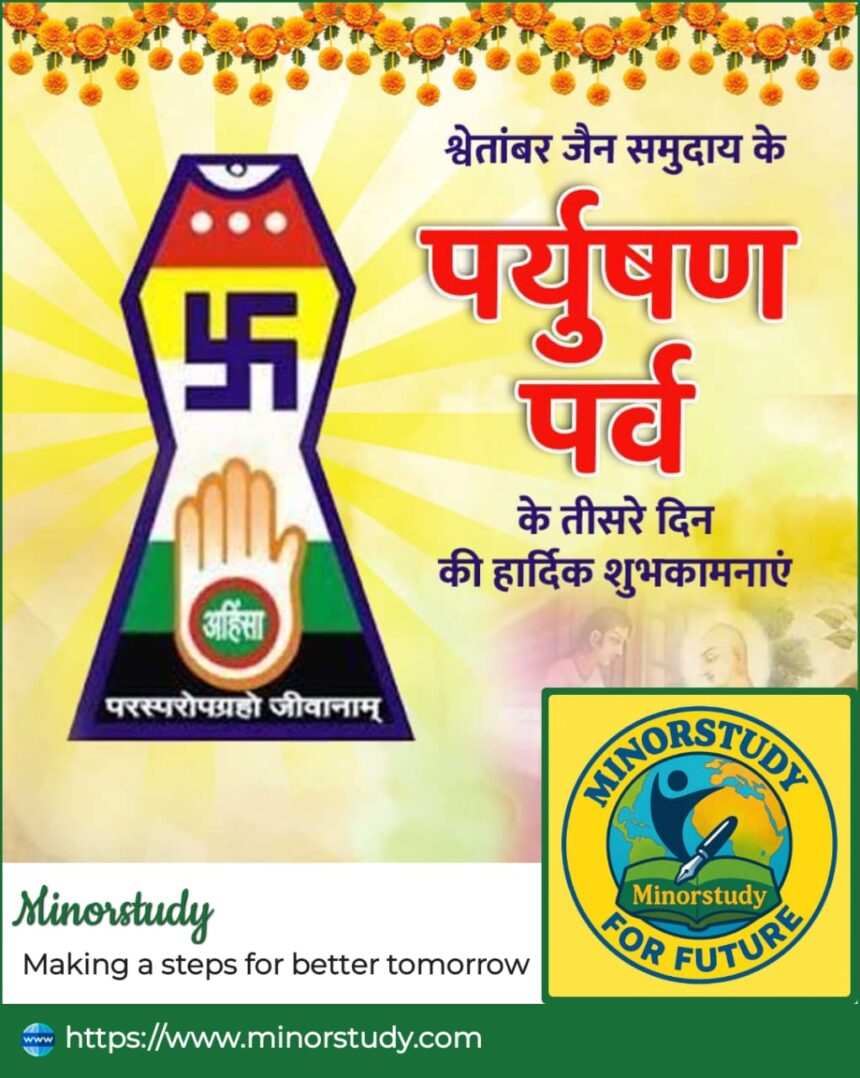Introduction: The Essence of Paryushan Parv
Paryushan Parv is one of the most important festivals celebrated by the Jain community across the world. Often called the festival of forgiveness and self-purification, it is a time of deep introspection, discipline, penance, and compassion. Jainism, one of the oldest religions of India, emphasizes non-violence (Ahimsa), truth (Satya), self-restraint (Brahmacharya), and forgiveness (Kshama) as guiding principles.
- Introduction: The Essence of Paryushan Parv
- 🌿 History of Paryushan Parv
- 🌟 Facts About Paryushan Parv
- 📜 Timeline of Paryushan Parv
- 🌼 Significance of Paryushan Parv
- 🙏 Observance of Paryushan Parv
- 🌍 Importance in Daily Life and Society
- 🎉 Wishing During Paryushan Parv
- ✅ Important Points to Remember
- ❓ FAQs on Paryushan Parv
- 🌟 Conclusion: Daily Life Impacts of Paryushan Parv
The festival typically lasts 8 days for Shwetambar Jains and 10 days for Digambar Jains, and during this period, devotees engage in prayers, fasting, meditation, scriptural study, and spiritual vows.
In today’s fast-paced world, where materialism often overshadows inner values, Paryushan Parv stands as a reminder of humanity’s higher purpose — self-reflection, harmony, and universal forgiveness.
🌿 History of Paryushan Parv
The word “Paryushan” comes from two Sanskrit roots:
“Pari” meaning all around
“Ushan” meaning to stay or to overcome
Together, it symbolizes “staying close to one’s soul by overcoming inner weaknesses.”
Historically, Jain monks and nuns were wanderers, but during the rainy season (Chaturmas), they stayed at one place due to practical reasons. This gave rise to a period of spiritual gatherings, teachings, and penance, which later evolved into Paryushan Parv.
The festival has been observed for over 2,000 years, and its roots can be traced back to the earliest Jain scriptures like Acharanga Sutra and Kalpa Sutra.
🌟 Facts About Paryushan Parv
Duration:
Shwetambar Jains: 8 days
Digambar Jains: 10 days (Das Lakshan Parv)
Core Teachings: Self-purification, forgiveness, penance, fasting, meditation, and seeking inner peace.
Special Day: The last day is observed as Samvatsari (Forgiveness Day), where Jains ask forgiveness by saying “Micchami Dukkadam” (May my faults be forgiven).
Dietary Discipline: Many Jains follow strict fasting, avoid root vegetables, and eat before sunset.
Scriptural Reading: Kalpa Sutra and Tattvartha Sutra are recited during this festival.
Equality in Practice: Both monks/nuns and laypeople participate actively.
📜 Timeline of Paryushan Parv
Ancient Times: Began as a seasonal practice of monks staying in one place during monsoon.
5th Century BCE: Systematized by Jain Acharyas as a period of penance and forgiveness.
Medieval Period: Became central to Jain cultural identity across India.
Modern Era: Now celebrated globally by Jain communities, with live sermons, digital gatherings, and mass forgiveness rituals.
🌼 Significance of Paryushan Parv
Spiritual Cleansing: A chance to shed inner impurities like anger, ego, greed, and deceit.
Forgiveness Ritual (Kshamapana): Strengthens human bonds by teaching humility.
Promotes Non-violence: Reminds humanity to reduce harm to all living beings.
Mental Discipline: Fasting and meditation enhance willpower and focus.
Social Harmony: Encourages peace, empathy, and mutual respect.
Cultural Identity: Preserves ancient Jain traditions in the modern era.
Universal Message: Goes beyond religion — forgiveness and non-violence are universal human needs.
🙏 Observance of Paryushan Parv
Daily Prayers: Chanting mantras, listening to sermons, and reading scriptures.
Fasting Practices: From partial fasting (Ekasan/Beasan) to complete fasting (Upvas). Some devotees fast for all 8 or 10 days.
Samvatsari Pratikraman: The final day when people ask for forgiveness from all beings.
Forgiveness Message: “Micchami Dukkadam” is exchanged with family, friends, and even strangers, symbolizing pure forgiveness.
Community Gatherings: Devotees attend discourses in temples or virtual platforms.
🌍 Importance in Daily Life and Society
Paryushan Parv is not just a religious event; it carries universal human lessons:
Forgiveness in Daily Life: Letting go of grudges reduces stress and improves relationships.
Self-Control: Dietary discipline teaches respect for health and environment.
Mental Peace: Meditation during Paryushan reduces anxiety and cultivates inner joy.
Social Relevance: In times of conflict and intolerance, Paryushan spreads the message of non-violence and harmony.
Sustainability: By practicing non-violence towards animals and plants, it indirectly promotes ecological balance.
🎉 Wishing During Paryushan Parv
On Samvatsari, Jains greet each other with humility:
“Micchami Dukkadam” – Forgive me if I have hurt you knowingly or unknowingly.
“Khamat Khamna” – A regional variation of asking forgiveness.
A warm Paryushan wish can be:
“May this Paryushan Parv bring peace, self-realization, and boundless forgiveness in your life. Micchami Dukkadam!”
✅ Important Points to Remember
Paryushan is about self-purification, not external rituals.
Forgiveness is its core value.
Observed differently by Shwetambar and Digambar sects but with a common essence.
Its teachings are relevant for all of humanity.
❓ FAQs on Paryushan Parv
Q1. What is the main purpose of Paryushan Parv?
A1. The main purpose is self-purification through penance, forgiveness, and spiritual reflection.
Q2. Why is forgiveness so important in Paryushan?
A2. Forgiveness helps dissolve anger, ego, and hatred, allowing peace and harmony to flourish.
Q3. Can non-Jains observe Paryushan?
A3. Yes. The values of non-violence, forgiveness, and inner peace are universal.
Q4. What is the difference between Shwetambar and Digambar observance?
A4. Shwetambars celebrate for 8 days, while Digambars observe 10 days as Das Lakshan Parv.
Q5. How is Samvatsari different from other days?
A5. Samvatsari is the final day of forgiveness, where all grudges are dissolved by saying “Micchami Dukkadam.”
🌟 Conclusion: Daily Life Impacts of Paryushan Parv
Paryushan Parv is more than a religious celebration — it is a philosophy of living. In a world filled with stress, conflicts, and negativity, this Jain festival teaches us that true strength lies in forgiveness, discipline, and compassion.
By practicing even a part of its principles — such as controlling our anger, forgiving others, eating mindfully, and respecting all beings — we can lead more peaceful, happy, and fulfilling lives.
In essence, Paryushan Parv is a reminder that the path to liberation and inner joy lies within us, and forgiveness is the first step toward that higher journey.









Thanks for another informative website. Where else may just I am getting that kind of information written in such an ideal method? I’ve a challenge that I am just now running on, and I have been at the glance out for such info.